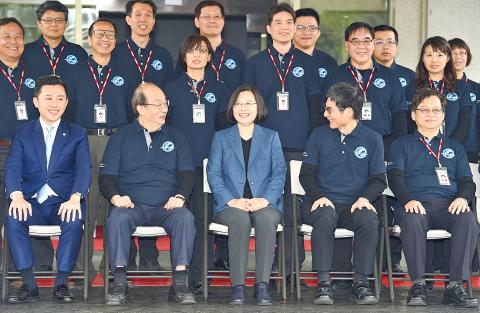The Formosat-7/COSMIC-2 satellite constellation would bolster national security by collecting more weather data, President Tsai Ing-wen (蔡英文) said yesterday as she inspected the Ministry of Science and Technology’s preparations for the next launch.
The Formosat-7 constellation, the biggest Taiwanese-US collaboration, is designed to collect more weather data for national defense and disease prevention purposes, Tsai said while visiting the National Space Organization (NSPO) at the Hsinchu Science Park (新竹科學園區).
The nation demonstrated its ability to develop space technology when Formosat-5 — Taiwan’s first domestically developed remote sensing satellite — was launched from Vandenberg Air Force Base in California on Aug. 25, 2017, she said, adding that the government would continue to support space technology development to make Taiwan an indispensable part of the global supply chain.

Photo: Liao Chen-huei, Taipei Times
After inspecting the organization’s integration and testing facilities, Tsai presented the constellation’s certification of flight readiness to NSPO Director-General Lin Chun-liang (林俊良).
The successor to the Formosat-3 constellation, dubbed “the world’s most precise thermometer in space,” the Formosat-7 constellation is expected to collect three to four times more data than its predecessor, Lin said.
It would be transported to the John F. Kennedy Space Center in Florida by China Airlines cargo aircraft and launched on a Space Exploration Technologies Falcon Heavy launch vehicle, he said, but added that the agency is still waiting for the US to set a launch date.
Formosat-7’s six mission satellites were manufactured by the Surrey Satellite Technology in England, a unit of Airbus Defense and Space, and are each equipped with three US-made instruments: the Tri-GNSS Radio Occultation System, an ion velocity meter and a radio frequency beacon, Lin said.
A seventh satellite, the Formosat-7R, also named Triton or “wind hunter,” was developed by the NSPO and would be launched next year at the earliest, NSPO Deputy Director-General Yu Shiann-jen (余憲政) said, adding that the agency would open an international tender for its launch.
Developing key satellite components is crucial to the nation’s third space program, which runs from this year until 2028, when it plans to launch six pilot high-resolution remote sensing satellites, two ultra-high-resolution remote sensing satellites and two synthetic aperture radar satellites, Minister of Science and Technology Chen Liang-gee (陳良基) said.
The program’s first remote sensing satellite is expected to be launched in 2021, Chen said.
In addition to the NSPO, academic and industrial resources would be involved in the program when necessary, he said, adding that many academics are keen to work on space exploration projects.

Beijing could eventually see a full amphibious invasion of Taiwan as the only "prudent" way to bring about unification, the US Department of Defense said in a newly released annual report to Congress. The Pentagon's "Annual Report to Congress: Military and Security Developments Involving the People's Republic of China 2025," was in many ways similar to last year’s report but reorganized the analysis of the options China has to take over Taiwan. Generally, according to the report, Chinese leaders view the People's Liberation Army's (PLA) capabilities for a Taiwan campaign as improving, but they remain uncertain about its readiness to successfully seize

Taiwan is getting a day off on Christmas for the first time in 25 years. The change comes after opposition parties passed a law earlier this year to add or restore five public holidays, including Constitution Day, which falls on today, Dec. 25. The day marks the 1947 adoption of the constitution of the Republic of China, as the government in Taipei is formally known. Back then the Chinese Nationalist Party (KMT) governed China from Nanjing. When the KMT, now an opposition party in Taiwan, passed the legislation on holidays, it said that they would help “commemorate the history of national development.” That

Taiwan has overtaken South Korea this year in per capita income for the first time in 23 years, IMF data showed. Per capita income is a nation’s GDP divided by the total population, used to compare average wealth levels across countries. Taiwan also beat Japan this year on per capita income, after surpassing it for the first time last year, US magazine Newsweek reported yesterday. Across Asia, Taiwan ranked fourth for per capita income at US$37,827 this year due to sustained economic growth, the report said. In the top three spots were Singapore, Macau and Hong Kong, it said. South

HORROR STORIES: One victim recounted not realizing they had been stabbed and seeing people bleeding, while another recalled breaking down in tears after fleeing A man on Friday died after he tried to fight the knife-wielding suspect who went on a stabbing spree near two of Taipei’s busiest metro stations, Taipei Mayor Chiang Wan-an (蔣萬安) said. The 57-year-old man, identified by his family name, Yu (余), encountered the suspect at Exit M7 of Taipei Main Station and immediately tried to stop him, but was fatally wounded and later died, Chiang said, calling the incident “heartbreaking.” Yu’s family would receive at least NT$5 million (US$158,584) in compensation through the Taipei Rapid Transit Corp’s (TRTC) insurance coverage, he said after convening an emergency security response meeting yesterday morning. National